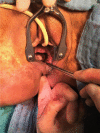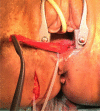Gracilis muscle transposition in complex anorectal fistulas of diverse types and etiologies: long-term results of 60 cases
- PMID: 36652018
- PMCID: PMC9849283
- DOI: 10.1007/s00384-022-04293-6
Gracilis muscle transposition in complex anorectal fistulas of diverse types and etiologies: long-term results of 60 cases
Abstract
Purpose: Complex fistulas often require several attempts at repair and continue to be a challenging task for the surgeon, but above all, a major burden for the affected patient. This study is aimed at evaluating the potential of gracilis muscle transposition (GMT) as a therapeutic option for complex fistulas of diverse etiologies.
Methods: A retrospective study was conducted over a period of 16 years with a total of 60 patients (mean age 50 years). All were treated for complex fistula with GMT at St. Josef's Hospital in Regensburg, Germany. Follow-up data were collected and analyzed using a prospective database and telephone interview. Success was defined as the absence of fistula.
Results: A total of 60 patients (44 women, 16 men; mean age 50 years, range 24-82 years) were reviewed from January 2005 to June 2021. Primary fistula closure after GMT was achieved in 20 patients (33%) and 19 required further interventions for final healing. Overall healing rate was 65%. Fistula type was heterogeneous, with a dominant subgroup of 35 rectovaginal fistulas. Etiologies of the fistulas were irradiation, abscesses, obstetric injury, and iatrogenic/unknown, and 98% of patients had had previous unsuccessful repair attempts (mean 3.6, range 1-15). In 60% of patients with a stoma (all patients had a stoma, 60/60), stoma closure could be performed after successful fistula closure. Mean follow-up after surgery was 35.9 months (range 1-187 months). No severe intraoperative complications occurred. Postoperative complications were observed in 25%: wound healing disorders (n = 6), gracilis necroses (n = 3), incisional hernia (n = 2), scar tissue pain (n = 2), suture granuloma (n = 1), and osteomyelitis (n = 1). In 3 patients, a second gracilis transposition was performed due to fistula recurrence (n = 2) or fecal incontinence (n = 1).
Conclusion: Based on the authors' experience, GMT is an effective therapeutic option for the treatment of complex fistulas when other therapeutic attempts have failed and should therefore be considered earlier in the treatment process. It should be seen as the main but not the only step, as additional procedures may be required for complete closure in some cases.
Keywords: Anal fistula; Gracilis muscle; Muscle transposition; Recurrent fistulas.
© 2023. The Author(s).
Conflict of interest statement
The authors declare no conflict of interest.
Figures





Similar articles
-
[Rectovaginal fistulas : Differentiated diagnostics and treatment].Chirurgie (Heidelb). 2024 Dec;95(12):1027-1040. doi: 10.1007/s00104-024-02151-5. Epub 2024 Sep 16. Chirurgie (Heidelb). 2024. PMID: 39283323 Review. German.
-
Gracilis muscle transposition for treatment of recurrent anovaginal, rectovaginal, rectourethral, and pouch-vaginal fistulas in patients with inflammatory bowel disease.Tech Coloproctol. 2019 Jan;23(1):43-52. doi: 10.1007/s10151-018-1918-7. Epub 2019 Jan 2. Tech Coloproctol. 2019. PMID: 30604248 Free PMC article.
-
Gracilis muscle transposition for fistulas between the rectum and urethra or vagina.Dis Colon Rectum. 2006 Sep;49(9):1316-21. doi: 10.1007/s10350-006-0585-3. Dis Colon Rectum. 2006. PMID: 16752191
-
Treatment of recurrent rectovaginal/pouch-vaginal fistulas by gracilis muscle transposition - a single center experience.J Visc Surg. 2013 Dec;150(6):379-82. doi: 10.1016/j.jviscsurg.2013.08.002. Epub 2013 Oct 18. J Visc Surg. 2013. PMID: 24144724
-
Gracilis Muscle Interposition for the Treatment of Rectovaginal Fistula: A Systematic Review and Pooled Analysis.Dis Colon Rectum. 2023 May 1;66(5):631-645. doi: 10.1097/DCR.0000000000002739. Epub 2023 Feb 3. Dis Colon Rectum. 2023. PMID: 36735766
Cited by
-
The use of the gracilis flap in colorectal surgery: surgical technique, results, and review of the literature.Int J Colorectal Dis. 2025 Jun 3;40(1):133. doi: 10.1007/s00384-025-04928-4. Int J Colorectal Dis. 2025. PMID: 40459766 Free PMC article. Review.
-
[Rectovaginal fistulas : Differentiated diagnostics and treatment].Chirurgie (Heidelb). 2024 Dec;95(12):1027-1040. doi: 10.1007/s00104-024-02151-5. Epub 2024 Sep 16. Chirurgie (Heidelb). 2024. PMID: 39283323 Review. German.
-
Sphincter-preserving surgical techniques in low rectal cancer management: A systematic review of contemporary evidence.World J Gastrointest Surg. 2025 Jul 27;17(7):107525. doi: 10.4240/wjgs.v17.i7.107525. World J Gastrointest Surg. 2025. PMID: 40740930 Free PMC article. Review.
References
MeSH terms
LinkOut - more resources
Full Text Sources

